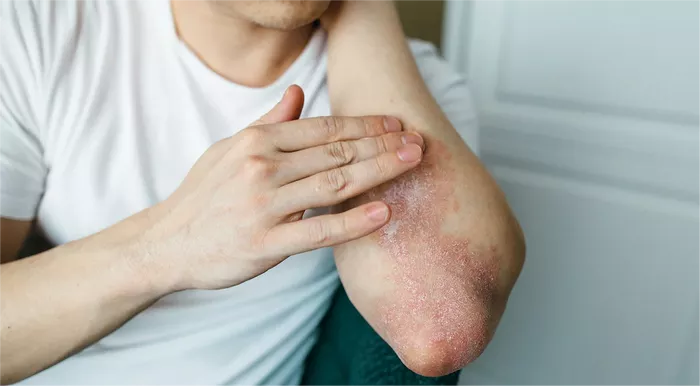Psoriasis is a chronic autoimmune condition that affects millions of people worldwide, causing the skin to undergo rapid cell turnover. This results in the development of raised, red patches covered with white or silvery scales, commonly known as lesions. The study and classification of these lesions play a crucial role in understanding the diverse manifestations of psoriasis and guiding effective treatment strategies.
Psoriatic Lesions: A Multifaceted Landscape
The term “lesion” refers to any abnormality or damage to tissue, and in the context of psoriasis, it encompasses a broad spectrum of skin abnormalities. These lesions are not mere cosmetic concerns; they are indicators of an intricate interplay between the immune system, genetics, and environmental factors.
1. Plaque Psoriasis: The Predominant Player
The most prevalent form of psoriasis is plaque psoriasis, characterized by well-defined, raised, red plaques covered with silvery scales. These plaques are the hallmark of psoriasis lesions and often appear on the elbows, knees, scalp, and lower back. The silvery scales result from the excessive production of skin cells, a key feature of psoriasis pathology.
2. Guttate Psoriasis: Small but Significant
Guttate psoriasis presents as small, drop-shaped lesions that are more widespread than the larger plaques seen in the classic form. These lesions often appear after a bacterial or viral infection and can affect the trunk, limbs, and scalp. Guttate psoriasis is commonly seen in children and young adults, adding another layer of complexity to the diagnosis and management of the condition.
3. Pustular Psoriasis: A Pustule Parade
In some cases, psoriasis takes on a more severe form known as pustular psoriasis, where raised, pus-filled blisters (pustules) form on the skin. These pustules are not infectious but can be painful and challenging to manage. This variant of psoriasis may be localized or involve larger areas of the body, necessitating specialized care and treatment approaches.
4. Inverse Psoriasis: Unveiling Hidden Challenges
Inverse psoriasis manifests in areas where skin surfaces touch or rub against each other, such as the armpits, groin, and under the breasts. Unlike the more common plaques, inverse psoriasis appears as smooth, red lesions without the typical scaling. This unique presentation can often lead to misdiagnosis, highlighting the importance of recognizing the diverse clinical expressions of psoriasis.
Understanding the Pathophysiology: Beyond the Surface
To comprehend the lesions of psoriasis, one must delve into the underlying pathophysiology of the condition. Psoriasis is fundamentally an immune-mediated disorder, with an overactive immune system triggering an inflammatory response in the skin.
1. The Role of T Cells: Orchestrators of Chaos
T cells, a type of white blood cell, play a central role in the development of psoriatic lesions. In individuals with psoriasis, these T cells become overactive, leading to an acceleration of the skin cell turnover process. This abnormal immune response results in the rapid proliferation of skin cells and the characteristic lesions seen in psoriasis.
2. Cytokines: Messengers of Inflammation
Interleukins, tumor necrosis factor-alpha (TNF-alpha), and other cytokines are key players in the inflammatory cascade observed in psoriasis. These signaling molecules contribute to the formation of psoriatic lesions by promoting the migration of immune cells to the skin and further amplifying the inflammatory response. Understanding the intricate cytokine network in psoriasis has paved the way for targeted therapies that specifically address these molecular pathways.
Lesions as Diagnostic Signposts: Navigating the Clinical Landscape
The diverse array of psoriatic lesions serves as invaluable diagnostic signposts for healthcare professionals. Recognizing the specific characteristics of each lesion type is crucial for accurate diagnosis and tailoring an effective treatment plan.
1. Differential Diagnosis Dilemmas
Psoriasis lesions can sometimes be confused with other skin conditions, such as eczema, seborrheic dermatitis, or fungal infections. A thorough understanding of the distinct features of psoriatic lesions aids in avoiding misdiagnosis and ensures that patients receive appropriate care from the outset.
2. Psoriasis Severity: Beyond Skin Deep
The extent and severity of psoriatic lesions vary among individuals, influencing the overall impact on quality of life. The Psoriasis Area and Severity Index (PASI) is a commonly used tool to assess the severity of psoriasis based on factors like redness, thickness of plaques, and the extent of skin involvement. Evaluating the severity of lesions guides clinicians in determining the most suitable treatment approach for each patient.
Treatment Approaches: Tailoring Solutions to Lesional Diversity
Addressing the lesions of psoriasis involves a multi-faceted approach, considering both the physical and psychological aspects of the condition. Various treatment modalities aim to alleviate symptoms, prevent flare-ups, and improve the overall well-being of individuals living with psoriasis.
1. Topical Treatments: Targeting the Surface
Topical corticosteroids, vitamin D analogs, and coal tar preparations are commonly prescribed for mild to moderate psoriasis lesions. These treatments focus on reducing inflammation, slowing down cell turnover, and alleviating symptoms on the skin’s surface.
2. Phototherapy: Harnessing the Power of Light
Phototherapy, or light therapy, involves exposing the skin to ultraviolet (UV) light under controlled conditions. This approach is particularly effective for patients with widespread lesions, as it helps to slow down the abnormal cell turnover and reduce inflammation. However, caution is required to prevent potential side effects associated with prolonged UV exposure.
3. Systemic Medications: Addressing the Root Cause
For severe and resistant cases, systemic medications such as methotrexate, cyclosporine, and newer biologic agents are employed. These medications target the immune system, interrupting the inflammatory cascade and providing relief from psoriatic lesions. The advent of biologics has revolutionized psoriasis treatment, offering targeted therapies with fewer systemic side effects.
4. Patient Education and Psychological Support
Living with psoriasis goes beyond managing physical symptoms; the psychological impact is equally significant. Educating patients about their condition, fostering a supportive environment, and addressing the emotional toll of psoriasis are integral components of a holistic treatment approach.
Research Frontiers: Unraveling the Psoriatic Puzzle
Ongoing research continues to unveil the intricate mechanisms behind psoriatic lesions, paving the way for innovative therapies and a deeper understanding of the condition. The exploration of genetic factors, the microbiome, and the role of lifestyle in psoriasis development opens new avenues for personalized medicine and targeted interventions.
1. Genetics and Psoriasis: Connecting the Dots
Genetic predisposition is a well-established factor in psoriasis development. Identifying specific genetic markers associated with psoriasis not only enhances our understanding of the condition’s origins but also holds the potential for developing targeted genetic therapies.
2. Microbiome Influence: Skin Deep Connections
The skin microbiome, consisting of diverse microbial communities, has emerged as a focal point in psoriasis research. Understanding how the microbiome interacts with the immune system and influences the development of psoriatic lesions may lead to novel therapeutic interventions that restore microbial balance and mitigate disease severity.
Conclusion
In conclusion, the lesions of psoriasis are not merely skin deep; they are manifestations of a complex interplay between genetics, the immune system, and environmental factors. Recognizing the diversity of psoriatic lesions is essential for accurate diagnosis and effective treatment planning. As we unravel the enigma of psoriasis, advancements in research and therapeutic modalities continue to reshape our approach, offering hope for improved outcomes and a better quality of life for those affected by this chronic condition.

























